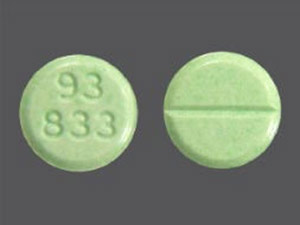Buy Clonazepam Online
Showing all 3 results
An overview of Clonazepam
Clonazepam is a generic prescription drug that works as a treatment to prevent and control seizures. This medication belongs to the benzodiazepines category of drugs known as anticonvulsants. It is also known as an antiepileptic drug since it helps in the treatment of epileptic seizures.
Clonazepam’s generic version is available with the brand names Klonopin and Klonopin Wafer. This drug treats specific seizure disorders, including Lennox-Gastaut syndrome and absence seizures in adults and children.
This medication is also helpful in the treatment of panic disorders such as agoraphobia in adults. Agoraphobia belongs to the category of anxiety disorder that makes people avoid places and situations that might cause the feeling of being trapped, helpless, embarrassed, panicked, or scared.
Warnings and precautions for Clonazepam
Warnings
Do not take Clonazepam (Klonopin) if you are allergic to it or any of its components. It may contain inactive ingredients that might cause health problems.
Keep this medication out of reach of children. In case of an accidental dose or overdose, take medical help or call the Poison control helpline right away.
Contraindication
- Documented hypersensitivity
- Hepatic impairment
- Acute narrow-angle glaucoma
Long-term effects of drug abuse
- Prolonged use of Clonazepam may result in both psychological and physical dependence.
- Abrupt withdrawal, particularly in people on high dose, long-term therapy, may precipitate status epilepticus; when discontinuing Clonazepam, slow withdrawal is essential; which is withdrawn gradually, the simultaneous substitution of other seizure treatments may be indicated.
Caution
- Withdraw it gradually while using this medication for panic disorder
- Use caution in sleep apnea, COPD (chronic obstructive pulmonary disease), open-angle glaucoma, renal or hepatic disease, suicidal ideation, depression
- Clonazepam is not under the recommendation for people with depressed neuroses, severe respiratory depression, psychotic reactions, acute alcohol intoxication, myasthenia gravis
- This drug may cause CNS depression resulting in impairment of the ability to perform hazardous tasks.
- Previous reports of hyperactive or aggressive behavior due to benzodiazepines in pediatrics, adolescents, and psychiatric patients
- Increased chances of suicidal thoughts or behavior with antiepileptic agents taking benzodiazepines
- Your doctor will ask you to use Benzodiazepine with caution because of the risk of drug dependency if you have ever had any substance use disorder or acute alcoholism. Prolonged use of this drug may also result in psychological and physical dependence.
- If one uses Clonazepam while having coexisting seizures disorders, this medication may increase incidence or precipitate onset of grand mal (generalized tonic-clonic seizures)
Clonazepam withdrawal
Abrupt withdrawal, specifically in people on high-dose therapy for a long time, may precipitate status epilepticus. But when discontinuing this medication, gradual withdrawal is necessary. While being withdrawn gradually, Clonazepam may indicate the simultaneous substitution of another anticonvulsant.
Pregnancy and lactation
- Your doctor may recommend you to take Clonazepam during pregnancy only if you are in a life-threatening emergency and no other safer drug is available. The human fetal risk may occur.
- This medication can be excreted in breast milk and is not under the recommendation for use while breastfeeding.
Clonazepam dosage
Panic disorder treatment
- 0.25 mg every 12 hours, initially increasing to 1 mg per day
after three days (may increase to 4 mg per day in some patients)
Seizure disorders treatment
- For seizures in adults, 1.5 mg per day is orally administered every 8 hours; there may be an increase by 0.5 mg to 1 mg every three days until you achieve the desired effect. Do not exceed the daily amount of more than 20 mg.
- For maintenance of seizures in adults, 2 to 8 mg orally, not to exceed 20 mg per day.
- Pediatric dosage for children younger than six years, a potent dose of 0.05 mg per kg
- Pediatric dosage for children younger than ten years (or less than 30 kg):
- 0.01 mg to 0.03 mg/kg daily divided every 8 hours; there may be an increase by 0.25 mg to 0.5 mg per day every three days to a maximum dose of 0.1 mg to 0.2 mg per kg/day orally in every 8 hours
- Maintenance dose: 0.1 mg to 0.2 mg per kg every day orally divided within 8 hours; not to exceed 0.2 mg/kg a day
- Pediatric dosage for children younger than ten years (or more than 30 kg):
- 1.5 mg per day divided every 8 hours; there may be an increase by 0.5 mg to 1 mg within every three days until the required effects are achieved; not to exceed 20 mg per day
- Maintenance amount: 2 mg to 8 mg orally; not to exceed 20 mg per day
Clonazepam side effects
It is pretty rare but not impossible to have an allergic reaction because of Clonazepam, and its signs may include hives, breathing conditions, swelling of the lips, tongue, or throat.
Common side effects of Clonazepam may include:
- Dizziness, drowsiness
- Memory problems
- Feeling tired or depressed
- Problems with walking or coordination
Severe side effects of Clonazepam may include:
- Severe drowsiness
- New or worsening seizures
- Unusual changes in mood or behavior
- Weak or shallow breathing
- Thoughts of hurting oneself or suicide
- Nightmares, hallucinations
- Unusual or involuntary eye movements
Report any worsening symptoms to your medical healthcare provider, such as:
- Anxiety, panic attacks
- Mood or behavior changes
- Trouble sleeping, or
- If you feel irritable, impulsive, hostile, agitated, restless, aggressive, physically or mentally hyperactive, or more depressed.
The sedative effects of this medication sustain for a more extended period in older adults, and accidental falls are prevalent in elderly patients taking benzodiazepines. One needs to use caution to avoid mishaps such as falls, accidents, or severe injuries.



